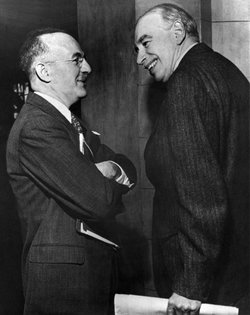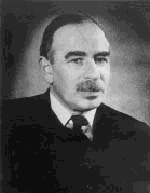John Maynard Keynes
|
|
John Maynard Keynes, 1st Baron Keynes of Tilton (pronounced Kaynes) (June 5, 1883 – April 21, 1946) was an English economist, whose radical ideas had a major impact on modern economic and political theory as well as Franklin D. Roosevelt's New Deal. He is particularly remembered for advocating interventionist government policy, by which the government would use fiscal and monetary measures to aim to mitigate the adverse effects of economic recessions, depressions, and booms. He is considered by many to be the founder of modern macroeconomics.
| Contents |
Biography
Education
John Maynard Keynes was the son of John Neville Keynes, an economics lecturer at Cambridge University and Florence Ada Brown, a successful author and a social reformist. Keynes enjoyed an elite early education at Eton, where he displayed talent in nearly every field of his unusually wide-ranging interests. His abilities were remarkable for their sheer diversity. He entered Kings College, Cambridge to study mathematics, but his interest in politics led him towards the field of economics, which he studied at Cambridge under A.C. Pigou and Alfred Marshall.
Career
In the interest of finding some source of income, Keynes postponed writing his dissertation for Cambridge, and instead took the civil service examinations, in which he placed second. Funnily enough, he got his worst grade in the economics portion, to which he remarked, The examiners presumably knew less than I did. The most desirable opening in the British Treasury being taken by the person who came first, Keynes accepted a job in the India Office, the demands of which he claims were so low that he divided his time between reading the newspaper and catching up on personal correspondence. Also during this time, he worked on his dissertation, which wasto his annoyancenot accepted when he submitted it, meaning also that the accompanying lifelong fellowship to Cambridge was not granted either. Instead, he accepted a lectureship in economics funded personally by Alfred Marshall, from which position he began to build his reputation as an economist. Soon he was appointed to the Royal Commission on Indian Currency and Finance, a position from which he could show his considerable talent at applying economic theory to practical problems. Having demonstrated such an aptitude, particularly with regards to currency and credit, his services were called on after the outbreak of the first World War. He worked for the Adviser to the Chancellor of the Exchequer and to the Treasury on Financial and Economic Questions. Among his responsibilities were the design of terms of credit between Britain and its continental allies during the war, and the acquisition of scarce currencies. At this latter endeavor Keynes nerve and mastery became legendary, in the words of Robert Lekachman, as in the case where he managed to put togetherwith difficultya small supply of Spanish pesetas and sold them all to break the market: it worked, and pesetas became much less scarce and expensive. These accomplishments led eventually to the appointment that would have a huge effect on Keynes life and career: financial representative for the Treasury to the 1919 Paris Peace Conference.
Keynes' career lifted off as an adviser to the British finance department from 19151919 during World War I, and their representative at the Versailles peace conference in 1919. The visit resulting in the publication of The Economic Consequences of the Peace the same year followed by A Revision of the Treaty in 1922 earned him public prominence. The works argued that the reparations which Germany was forced to pay to the victors in the war were too large and would lead to the ruin of the German economy. These predictions were arguably borne out when the German economy collapsed in the hyperinflation of 1923, with only a small amount of reparations ever being paid.
Keynes published his Treatise on Probability in 1920, a notable contribution to the philosophical and mathematical underpinnings of probability theory. He attacked the deflation policies of the 1920s with A Tract on Monetary Reform in 1923, a trenchant argument that countries should target stability of domestic prices and proposing flexible exchange rates. The Treatise on Money 1930 (2 volumes) effectively set out his Wicksellian theory of the credit cycle.
His magnum opus, The General Theory of Employment, Interest and Money challenged the economic paradigm when published in 1936. In this book Keynes put forward a theory based upon the notion of aggregate demand to explain variations in the overall level of economic activity, such as were observed in the Great Depression. The total income in a society is defined by the sum of consumption and investment; and in a state of unemployment and unused production capacity, one can only enhance employment and total income by first increasing expenditures for either consumption or investment.
John_maynard_keynes.jpg
The total amount of saving in a society is determined by the total income and thus, the economy could achieve an increase of total saving, even if the interest rates were lowered to increase the expenditures for investment. The book advocated activist economic policy by government to stimulate demand in times of high unemployment, for example by spending on public works. The book is often viewed as the foundation of modern macroeconomics and had a profound impact on U.S. president Roosevelts New Deal.
In 1942 Keynes was a very recognised economist and was raised to the peerage as Baron Keynes of Tilton. During World War II, Keynes argued in How to pay for the war that the war effort should be largely financed by higher taxation, rather than deficit spending, in order to avoid inflation. As Allied victory began to look certain, Keynes was heavily involved, as leader of the British delegation and chairman of the World Bank commission, in the negotiations that established the Bretton Woods system. The Keynes-plan, concerning an international clearing-union argued for a radical system for the management of currencies, involving a world central bank, the Bancor, responsible for a common world unit of currency. The USA's greater negotiating strength, however, meant that the final outcomes accorded more closely to the less radical plans of Harry Dexter White.
Keynes wrote Essays in Biography and Essays in Persuasion, the former giving portraits of economists and notables, whilst the latter presents some of Keynes' attempts to influence decision-makers during the Great Depression. Keynes was editor in chief for the Economical Journal from 1912.
Investor
Keynes' brilliant record as an investor is demonstrated by the publicly available data of a fund he managed on behalf of King's College, Cambridge.
From 1928 to 1945, despite taking a massive hit during the Crash of 1929, Keynes' fund produced a very strong average increase of 13.2% compared with the general market in the United Kingdom declining by an average 0.5% per annum.
The approach generally adopted by Keynes with his investments he summarised accordingly:
- 1. A careful selection of a few investments having regard to their cheapness in relation to their probable actual and potential intrinsic value over a period of years ahead and in relation to alternative investments at the time;
- 2. A steadfast holding of these fairly large units through thick and thin, perhaps for several years, until either they have fulfilled their promise or it is evident that they were purchases on a mistake, and;
- 3. A balanced investment position, i.e. a variety of risks in spite of individual holdings being large, and if possible opposed risks (e.g. a holding of gold shares among other equities, since they are likely to move in opposite directions when there are general fluctuations).
Keynes argued that "It is a mistake to think one limits one's risks by spreading too much between enterprises about which one knows little and has no reason for special confidence ... One's knowledge and experience are definitely limited and there are seldom more than two or three enterprises at any given time in which I personally feel myself to put full confidence."
Keynes' advice on speculation, some might say, is timeless:
- (Investment is) intolerably boring and over-exacting to any one who is entirely exempt from the gambling instinct; whilst he who has it must pay to this propensity the appropriate toll.
When reviewing an important early work on equities investments, Keynes argued that "Well-managed industrial companies do not, as a rule, distribute to the shareholders the whole of their earned profits. In good years, if not in all years, they retain a part of their profits and put them back in the business. Thus there is an element of compound interest operating in favor of a sound industrial investment."
Personal and Marital life
Standing at approximately 6' 9", Keynes was very tall even by today's standards. In the early part of his life he was a practicing homosexual. He had a series of sexual relationships with men during his university days, and a serious relationship with the Bloomsbury painter Duncan Grant from 1908 to 1915. Keynes continued to assist Grant financially for the rest of his life. Keynes met Lydia Lopokova, a well-known Russian ballerina, in October 1917. By most accounts, Keynes enjoyed a happy marriage with Lopokova. They were unable to have children for medical reasons.
Keynes was ultimately a successful investor building up a substantial private fortune. He was nearly wiped out following the Wall Street Crash but soon recouped his fortunes. He enjoyed collecting books and for example collected and protected during his lifetime many of Isaac Newton's papers. Keynes died of cardiac infarction, his heart problems being aggravated by the strain of working on post-war international financial problems.
His brother Sir Geoffrey Keynes (1887-1982) was a distinguished surgeon, scholar and bibliophile. His nephews are Richard Keynes (born 1919), a physiologist, and Quentin Keynes (1921-2003) an adventurer and bibliophile.
Influences on Keynes' works
Keynes' influence
Keynes' theories were so influential, even when disputed, that a subfield of Macroeconomics called Keynesian economics is further developing and discussing his theories and their applications. John Maynard Keynes had several cultural interests and was a central figure in the so-called Bloomsbury group, consisting of prominent artists and authors in Great Britain. His autobiographical essays Two Memoirs appeared in 1949.
Critique
The work 1930 Treatise on Money (2 volumes) was regarded as Keynes's best work by his frequent intellectual opponent, Milton Friedman. Friedman and other monetarists have argued that Keynesian Economists do not pay enough attention to stagflation and other inflationary issues.
- Friedrich von Hayek reviewed the Treatise on Money so harshly that Keynes decided to set Piero Sraffa to review (and condemn no less harshly) Hayek's own competing work. The Keynes-Hayek conflict was but one battle in the Cambridge-LSE war.
- Ludwig von Mises
- Rational expectations
Miscellaneous
References
- Essays on John Maynard Keynes, Milo Keynes (Editor), Cambridge University Press, 1975, ISBN 0-521-20534-4
- John Maynard Keynes: Hopes Betrayed 1883-1920, Robert Skidelsky, Papermac, 1992, ISBN 033357379X (US Edition: ISBN 014023554X)
- John Maynard Keynes: The Economist as Saviour 1920-1937, Robert Skidelsky, Papermac, 1994, ISBN 0333584996 (US Edition: ISBN 0140238069)
- John Maynard Keynes: Fighting for Britain 1937-1946 (published in the United States as Fighting for Freedom), Robert Skidelsky, Papermac, 2001, ISBN 0333779711 (US Edition: ISBN 0142001678)
See also
External links
- Bio, bibliography, and links (http://cepa.newschool.edu/het/profiles/keynes.htm)
- Template:Gutenberg author
- Bio at Time 100 - the most important people of the century (http://www.time.com/time/time100/scientist/profile/keynes.html)bg:Джон Мейнард Кейнс
ca:John Maynard Keynes cs:John Maynard Keynes da:John Maynard Keynes de:John Maynard Keynes es:John Maynard Keynes eo:John Maynard KEYNES fr:John Maynard Keynes id:John Maynard Keynes is:John Maynard Keynes it:John Maynard Keynes he:ג'ון מיינרד קיינס nl:John Maynard Keynes ja:ジョン・メイナード・ケインズ no:John Maynard Keynes oc:John Maynard Keynes pl:John Maynard Keynes pt:John Maynard Keynes sk:John Maynard Keynes sr:Џон Мејнард Кејнс fi:John Maynard Keynes sv:John Maynard Keynes tr:John Maynard Keynes uk:Кейнс Джон Мейнард zh:约翰·梅纳德·凯恩斯

